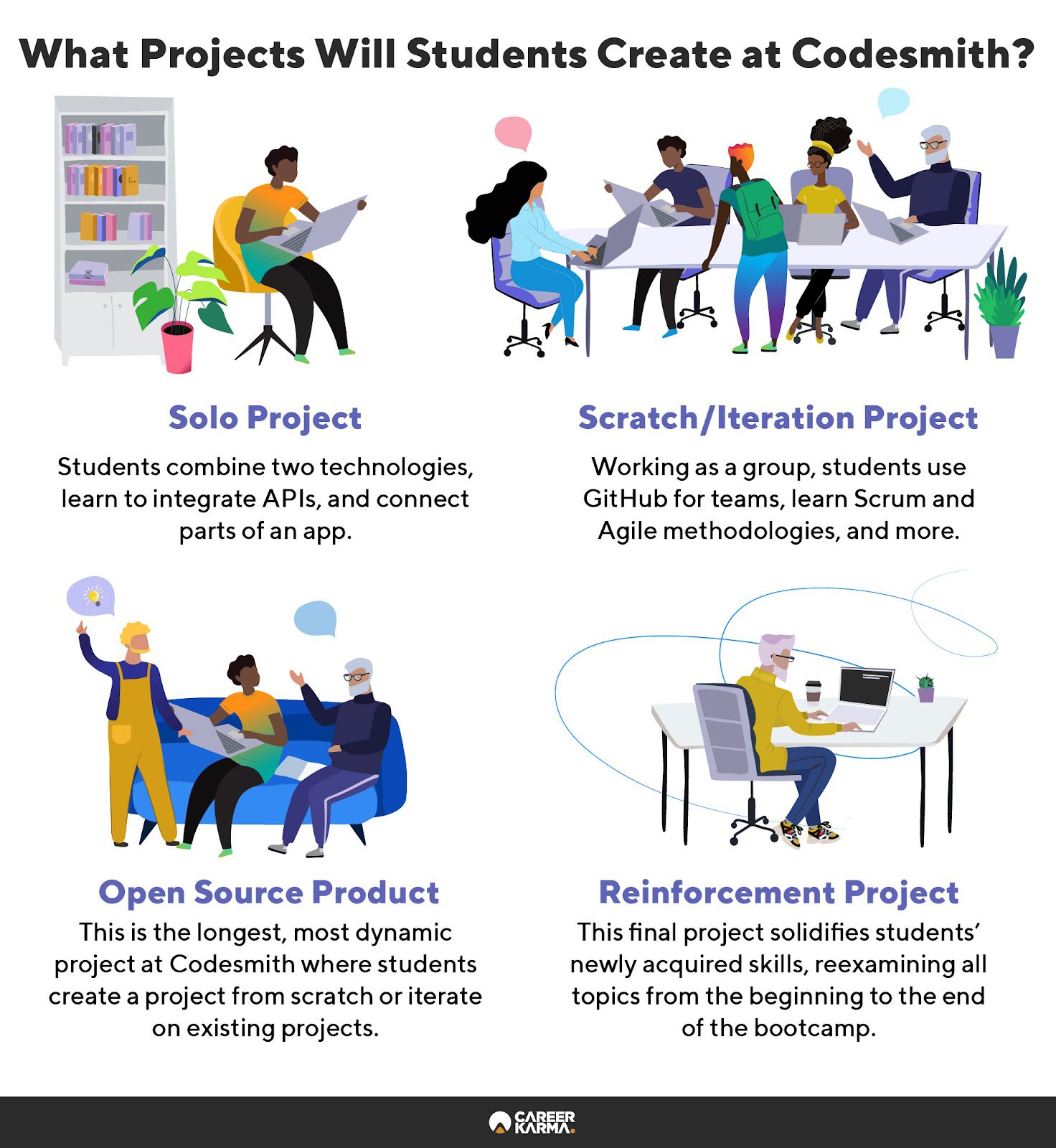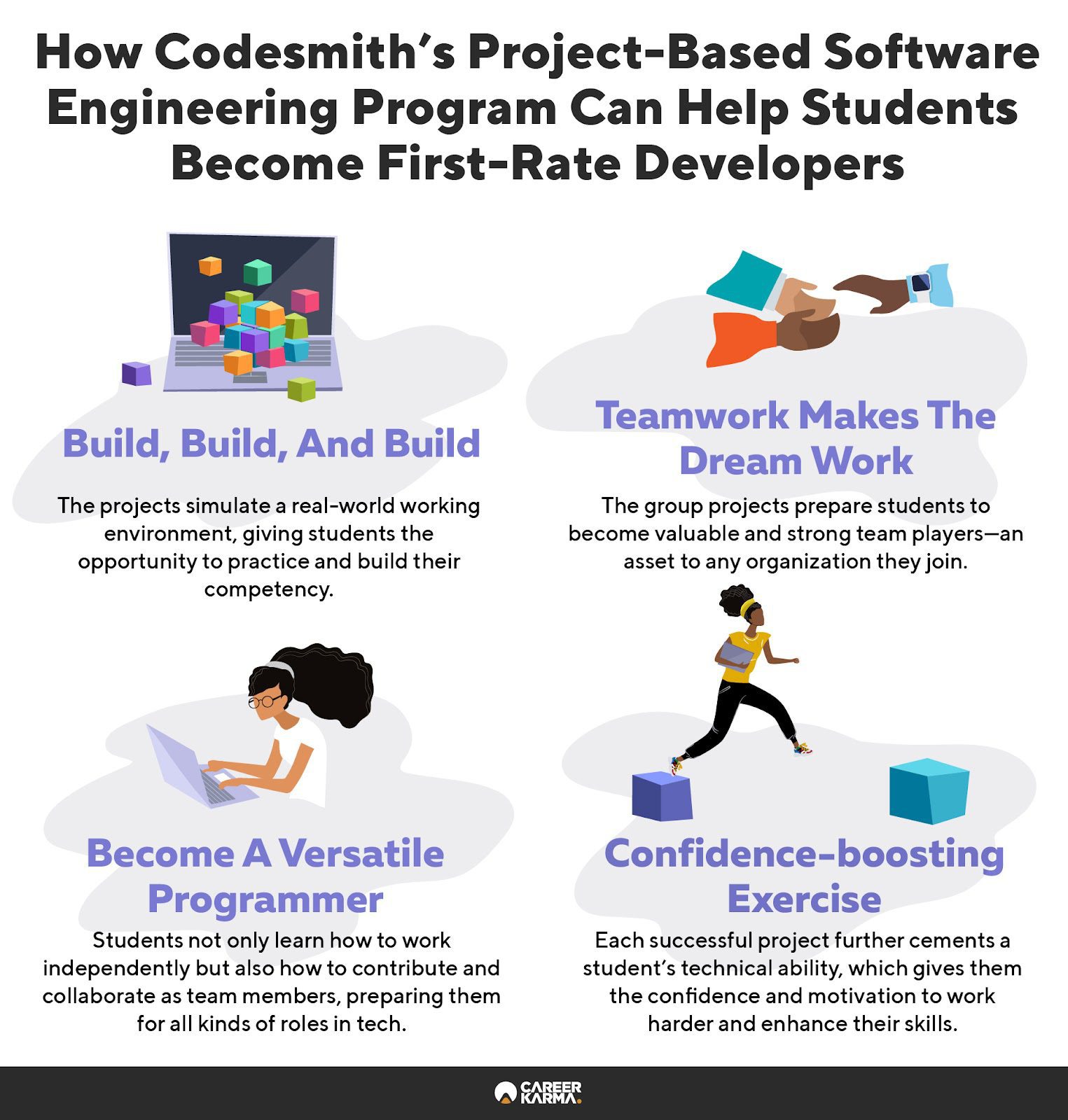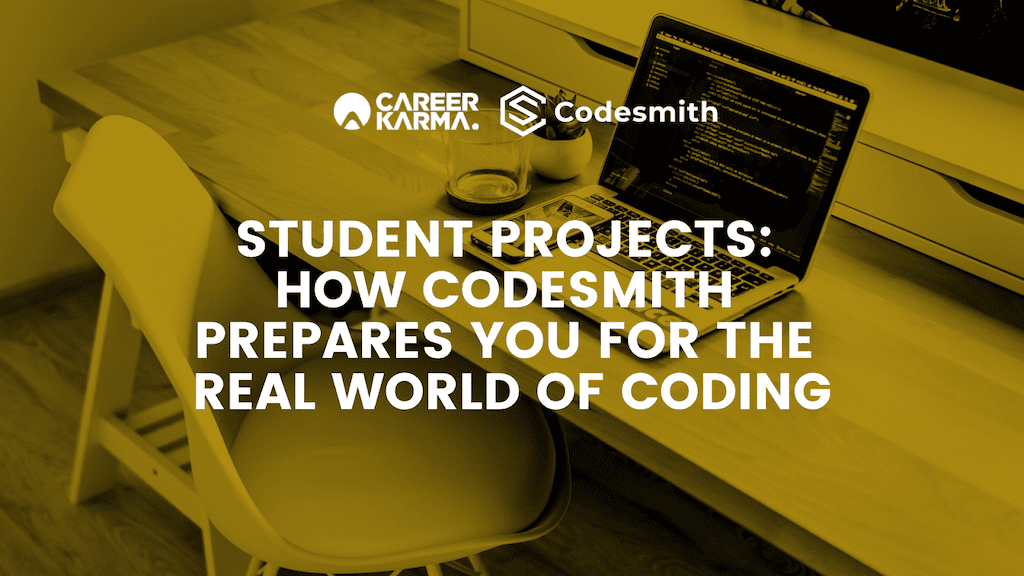Codesmith is a software engineering bootcamp that puts collaboration at the forefront of its training model. Its structure includes four major projects, where students learn from one another, test their skills, and prepare for the tech workforce. The web applications and Open Source Products that Codesmith residents build not only help them stand out in their job search, but also push technology forward.
If you’re wondering whether Codesmith is the right coding bootcamp for you, you might be scouring the web to get an honest inside look at what goes down during the bootcamp. And who better to tell you about it than graduates of the program themselves?
Weilan Cui was looking to make a jump from pharmacy to tech. Frank Stepanski wanted to build on his development and project management skills. Dwayne Richards was an engineering major and a firefighter seeking a new career path. And Tyler Martinez was an actor with a burgeoning interest in tech.
Each of them came from a different background before Codesmith. Yet all of them found their way to Codesmith and dove deep into the full-time and part-time Software Engineering Remote Immersive programs.
Read on to hear about their experiences at Codesmith, the projects they built, the communities they formed, the skills they developed, and the advice they would give others in a similar position.
Codesmith is a hands-on coding bootcamp with a focus on teamwork, collaboration, and project-building, preparing students for software engineering careers.
Apply to Codesmith today.What Is the ‘Codesmith Experience?’
Codesmith offers a Software Engineering Immersive Program in two formats: 12-week full-time and 38-week part-time. Due to COVID-19, courses are currently fully remote. Regardless of the mode, the core part of Codesmith is its robust and in-depth lessons and its hands-on approach to coding.
Codesmith believes that practical learning allows students to get a feel of the tasks that they would have to perform as real-life software engineers. However, the school knows that a successful career takes more than technical proficiency; it also requires effective collaboration and strong communication skills. These are what Codesmith’s projects aim to achieve.
What Projects Will You Create at Codesmith?

Codesmith students take on four projects throughout the bootcamp, completed in the order listed below:
1. Solo Project
The solo project comes after the first month of lessons at Codesmith. Focusing on one to two technologies like OAuth, Databases, React, and Redux, students learn to integrate APIs and connect different parts of an application.
This was Weilan’s favorite project. Coming from a non-tech background, she was thrilled to see the skills she just acquired put to the test.
“It seemed really daunting at first, but I was quite surprised that I really liked it. I figured out that I could finagle my way through a project, and it’s cool to see what you can make,” she said. Weilan’s project was using Puppeteer to scrape Craigslist.
Examples of previous solo projects completed by Codesmith students include a WebSocket chess game, Google Maps with Spotify integration, and an e-commerce clothing store.
2. Scratch/Iteration Project
The Scratch/Iteration project is the first team project students engage in at Codesmith. Students use GitHub for teams along with more complex technologies and learn about teamwork in the process.
Frank and Tyler both enjoyed this exercise as it exposed them to collaborative work. “You’re with three to five people, and you’re very enthusiastic to start something fresh and collaborate,” Frank said.
Tyler found that it was a great and healthy opportunity to see how his level of knowledge matched up to others. “You also start to get into that Scrum ideology, meeting up and working as a team, and tackling a component together.”
3. Open Source Product
This is the central project at Codesmith and the one that alumni highlight in their first job interviews. The direct job training on hard technologies that this project provides allows students to gain experience way before they set foot in the workplace.
Once students find their group, they participate in a seven-day Ideation Week for the full-time program and 14-day Ideation Week for the part-time program. This includes activities like brainstorming, researching, and developing a pitch. “You come up with three ideas of what you’d want to work on and then present them to Codesmith’s Lead Instructors. They’ll recommend which you should move forward with,” Frank said.
Students can choose to either create a project from scratch or iterate on an existing Codesmith project developed by previous students. Either way, students end up solving major challenges in the industry today and focus on tough engineering judgments. They also dive into technology through developer-oriented projects in key web software engineering areas like UI frameworks, Node.js, DevOps, or client projects.
Weilan Cui
Weilan’s Open Source Product involved using VNO, compiling, and bundling Vue single-file components. “I thought it was a really cool project, and I fell in love with the idea. I wanted to bring on live reloading.”
Frank Stepanski
Frank’s Open Source Product focused on building a Svelte Storm IDE, a front end programming framework similar to React but different in how it builds out the UI. To decide on the focus of your project, Frank notes that you should look for gaps in the developer experience that you can fill with your idea.
“If your group chooses to iterate on something, you [will be] working with a codebase that’s not yours. If you’re going to be walking into a company, you’ll be working on production-level code with many lines that you haven’t seen before.”
Dwayne Richards
Dwayne’s project was a scaffolding tool, a command-line interface developer tool for creating a new project based on input from a developer. They were the second group to iterate on it. “We chose it because it allowed the team members to speak very specifically about limitations in Node. Going into the workplace, those things give you a lot of insight.”
Dwayne’s team implemented a structure to their workflow, in part thanks to a team member who had engineering experience. “We did a decent job scoping out what would be possible within the time necessary and delegating tasks, and we attempted agile development to create sprints.”
Tyler Martinez
Tyler’s team iterated on an existing project, adding features and a backend to Spearmint. They started by getting everyone to work to their strengths.
“We worked out on the first run where people’s strong suits were. We split features into frontend and backend. Later, we decided that we needed to treat this project as a learning opportunity, so people switched to where they were less strong to bolster that skillset.”
Commenting on his experience, Tyler said, “It was a beast, but a resume builder. You have the opportunity to iterate or create your own. If you iterate, you dive into a codebase you didn’t create. If you create, you have so much code you have to write.”
4. Reinforcement Project
The Reinforcement Project is the last project that students complete at Codesmith and seeks to strengthen what students have learned during their time at the program.
This was Dwayne’s favorite project, aside from the Open Source Product. He said that the first half of Codesmith, called the junior portion, goes by very quickly because of all the new information students acquire.
“The reinforcement project helps you round out the skills you picked up in the junior portion, coupled with what you learned in the senior portion, the Open Source Product.”
It helps students circle back to things that they learned at the beginning and compound it with what they’ve learned since. This gives students a benchmark for how far they have come. It also allows students to try out roles they haven’t had a chance to in other projects.
“I felt like I actually knew what I was doing for the first time,” Dwayne said. “That, coupled with it being the last project and everybody being happy to approach the end, made it delightful.” Tyler, too, felt that this project allowed him to grow confident in his skills. “It really solidified the idea that you can build an application.”
How Codesmith Promotes Active Collaborations

Teamwork and cooperation are a huge part of Codesmith’s pedagogy. Much of the program advance team-based projects. On top of that, active collaborations are prevalent throughout every phase of Codesmith’s software engineering program.
Residents learn in-demand modern technologies, build production-level Open Source Products, and consistently work in collaboration with other engineers to become leadership-driven, autonomous problem solvers ready for mid- to senior-level software engineering roles.
“Each week, you work on a different topic and pair-program on mini assignments. You work with one or two people, and you get used to that. [The instructors] give you a pair programming partner at the beginning of the week, then they allow you to pair up with another team during the week to share ideas,” Frank explained.
This allows students to become familiar with collaborative exercises by the time projects roll around.
For the Open Source Product project, students can indicate their preferred partners in a questionnaire provided by Codesmith. There’s no guarantee that they will end up with who they choose, but most students have the chance to become teammates with someone they’ve previously worked well with.
Empathetic Engineering
All four alums note that the different aspects of collaboration have been integral to their experience at Codesmith. “Being in that kind of environment, collaborating with people, and working in team settings, you learn a lot about yourself and have a lot of growth,” said Weilan.
“I’m glad they put us through that pressure cooker because when you encounter these dynamics, it’s not actually in the workplace. It’s in a safe environment for you to develop and make mistakes.”
Weilan felt that she wasn’t the most technically skilled among her classmates, so she wasn’t confident enough to work in a team environment. But through the collaborative nature of Codesmith, she learned to speak up.
“I realized that even though you’re insecure, you [can] still contribute. I did have really good ideas and was actually able to help.”
Dwayne and Tyler both noted that empathetic engineering is a huge part of Codesmith’s methodology, and this is apparent in the way the bootcamp approaches collaborative learning.
Being an empathetic engineer means not leaving anyone behind. It means working together to make sure everybody understands what they’re doing and creating an environment where everyone feels seen and heard.
Tyler notes that this collaborative aspect of the bootcamp solidified his passion for coding. “The thing that stuck out the most to me about Codesmith was the community. The more I bonded with my cohort mates, the more I learned that this is what I want, and I wanted to land in a job that felt the same as the bootcamp, community-wise.”
Learn, Build, Collaborate, and Grow with Codesmith
Codesmith’s projects build the students’ confidence in their technical proficiency and allow them to hone the interpersonal skills that will prepare them for job interviews and for navigating future workplaces.
Each Codesmith alumni featured in this article has advice and thoughts for aspiring Codesmith students to take advantage of the opportunity and launch a successful career.
Weilan recommends that potential students come in prepared, considering the demands of the program and the amount of information that students absorb. “It’s intense and demanding. Take some time in between whatever you’re doing before Codesmith to get in the right mindset and really go through the prep work they offer.”
Frank’s biggest takeaway is to learn how to balance out what you can learn from other people and what you can share with them. “Codesmith pushes you to problem solve, and that’s an essential skill. Codesmith teaches you how to communicate your problems and figure out how to solve them on your own, or try to, before asking for help,” he said.
For Dwayne, students must be strategic when choosing and planning for their Open Source Product. “Take some time to look at what’s happening in the job market, and use that to decide on your project,” he said. “Codesmith gives you a lot of insight into that, too. You’ll be talking to hiring managers mostly about your Open Source Product, so see what hiring managers are looking for in the current market.”
Meanwhile, Tyler believes that students will walk away from Codesmith as highly competent and well-rounded software engineers with a knack for teamwork.
“You have to adjust the way you are to work with other people, depending on how they are. Getting to know where everyone’s strengths and weaknesses lie, as well as your own, is important. So is reaching out to your team to ask for help, having that humble mentality of accepting you don’t know everything, and allowing yourself to grow from there.”
Are you ready to collaborate and build projects that will boost your resume and test your knowledge? Codesmith might be the coding school for you. Start your application here.
About us: Career Karma is a platform designed to help job seekers find, research, and connect with job training programs to advance their careers. Learn about the CK publication.




